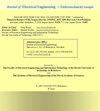Influence of nanofiller concentration on polypropylene nanocomposites for high voltage cables
IF 1.2
4区 工程技术
Q4 ENGINEERING, ELECTRICAL & ELECTRONIC
Journal of Electrical Engineering-elektrotechnicky Casopis
Pub Date : 2022-06-01
DOI:10.2478/jee-2022-0023
引用次数: 0
Abstract
Abstract Polymeric insulation for HVDC cable is attracting more attention in the modern power transmission system. Especially, the thermoplastic material is desirable for power cable insulation because of its recyclability and ease of processing. Thermoplastic material development is a good alternative to cross-linked polyethylene in the future. Polypropylene has the advantage of avoiding by-products during cable production, which can minimize space accumulation and degassing costs. Therefore, this study investigates the influence of nanofillers on the structural properties of isotactic polypropylene. In addition, the proposed composite material’s morphology, melting, dielectric permittivity, and breakdown strength are examined. Different weight percentages of inorganic nanofillers such as TiO2 and ZnO are used to make nanocomposite thin films. With increasing filler concentration, the dielectric constant of the nanocomposite thin film increases. Apart from that, the dielectric loss of the TiO2 nanocomposite thin film increases with weight percentage initially and it falls nearer to virgin material at a higher frequency. The breakdown strength of the nanocomposite materials shows a similar variation with filler concentration. TiO2 is more resistant to deterioration than ZnO composite. Based on the results of the complete investigation, the TiO2 nanocomposite is better suited for the insulation of HVDC cables.纳米填料浓度对高压电缆用聚丙烯纳米复合材料性能的影响
摘要高压直流电缆的聚合物绝缘在现代输电系统中受到越来越多的关注。特别是热塑性材料因其可回收性和易于加工而成为电力电缆绝缘的理想材料。热塑性材料的发展是未来替代交联聚乙烯的良好选择。聚丙烯在电缆生产过程中具有避免副产品的优点,可以最大限度地减少空间积累和脱气成本。因此,本研究探讨了纳米填料对等规聚丙烯结构性能的影响。此外,所提出的复合材料的形貌,熔融,介电常数和击穿强度进行了测试。采用不同重量百分比的无机纳米填料(如TiO2和ZnO)制备纳米复合薄膜。随着填料浓度的增加,纳米复合薄膜的介电常数增大。此外,TiO2纳米复合薄膜的介电损耗最初随重量百分比的增加而增加,在较高的频率上更接近原始材料。纳米复合材料的击穿强度随填料浓度的变化规律相似。TiO2比ZnO复合材料更耐劣化。基于完整的研究结果,TiO2纳米复合材料更适合于高压直流电缆的绝缘。
本文章由计算机程序翻译,如有差异,请以英文原文为准。
求助全文
约1分钟内获得全文
求助全文
来源期刊
CiteScore
1.70
自引率
12.50%
发文量
40
审稿时长
6-12 weeks
期刊介绍:
The joint publication of the Slovak University of Technology, Faculty of Electrical Engineering and Information Technology, and of the Slovak Academy of Sciences, Institute of Electrical Engineering, is a wide-scope journal published bimonthly and comprising.
-Automation and Control-
Computer Engineering-
Electronics and Microelectronics-
Electro-physics and Electromagnetism-
Material Science-
Measurement and Metrology-
Power Engineering and Energy Conversion-
Signal Processing and Telecommunications

 求助内容:
求助内容: 应助结果提醒方式:
应助结果提醒方式:


